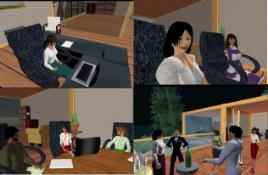Students 'game to learn' in personalised environments
Published on 20 November, 2008
CQUniversity is at the forefront of a trend which favours students establishing their own personalised learning environments (PLEs) to support their lifelong learning.
The students' PLE meshes with campus computer systems but otherwise enables cherry-picking of their favourite technology tools.

Case studies with a difference
One of the many ideas is that students will be able to interact with each other by harnessing the inner world of video games and other immersive environments. There's already been a step towards harnessing these environments in the use of machinima (machine cinema).
An auditing lecturer and support team produced case study videos by using virtual actors in the Second Life internet world - much cheaper than hiring real actors and constructing sets - to spice up written materials.
CQUniversity's $500,000 Personal Learning Environments (PLEs) project started on a small scale this year, expanding on existing innovations, and will continue in 2009 to engage a broader range of courses and innovations.
It goes beyond the suite of technologies, including wikis, blogs, RSS feeds and voice threads, to an emphasis on how the technologies can be used to enhance educational innovations, such as lifelong learning, and further reinforce CQUniversity's ability to be open and adaptive.
"Learning neither starts nor stops at the door of the institution," says project coordinator David Jones.
"We are going beyond the idea that e-learning assumes it is the role of the institution to provide and control all aspects of technology used by the learner and teacher, or even all of the learning in which a learner engages. We need to adapt to what they are already doing and using."
As an example, Mr Jones said that, in recent years, CQUniversity academics have been been observing and marking over 1400 student blogs using Blog Aggregation Management (BAM) software.
"The BAM software offered a window on the blog activity," he said.
"Students could use whatever blog service they wanted, or were already using. CQUni didn't need to purchase or support blog software. We work with the software the students choose and provide the small amount of software we need for our requirements.
"The BAM software integrated with campus systems that supported online submission, management and marking of assignments as well as plagiarism detection. Instructors thus were able to monitor progress and offer feedback as the course progressed."
The PLEs project intersects with the University's involvement (with USQ) in a $200,000 Australian Learning and Teaching Council (ALTC) project exploring the potential of immersive virtual worlds.

